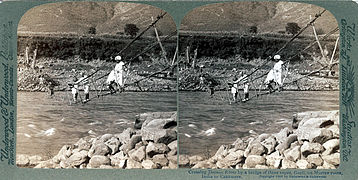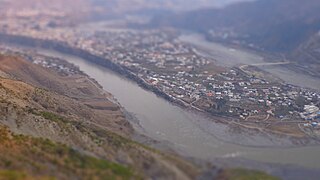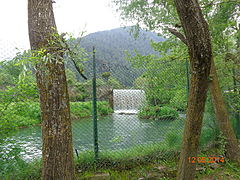geo.wikisort.org - River
The Jhelum River[needs IPA] is a river in the northern Indian subcontinent, mainly in the Northern Punjab region of Pakistan. It originates at Verinag and flows through the Indian administered territory of Jammu and Kashmir, to the Pakistani-administered territory of Kashmir, and then into the Pakistani province of Punjab. It is the westernmost of the five rivers of the Punjab region, and flows through the Kashmir Valley. It is a tributary of the Chenab River and has a total length of about 725 kilometres (450 mi).[6]
This article needs additional citations for verification. (November 2007) |
| Jhelum | |
|---|---|
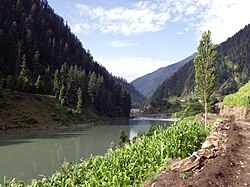 Jhelum River photographed in Pakistan, c. 2006 | |
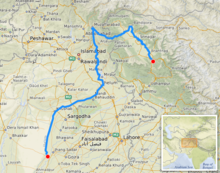 | |
| Location | |
| Countries | India, Pakistan |
| Physical characteristics | |
| Source | |
| • location | Verinag Spring |
| Mouth | |
• location | Chenab River |
| Length | 725 km (450 mi) |
| Discharge | |
| • average | 1,026.6 m3/s (36,250 cu ft/s) (near Mangla Dam) |
| • minimum | 234.19 m3/s (8,270 cu ft/s) (near Mangla Dam) |
| • maximum | 26,419.13 m3/s (932,983 cu ft/s) (near Mangla Dam) |
| Discharge | |
| • average | 313.19 m3/s (11,060 cu ft/s) (near Domel) |
| Discharge | |
| • average | 229.20 m3/s (8,094 cu ft/s) (near Baramulla) |
| Basin features | |
| River system | Indus River |
| Tributaries | |
| • left | Poonch River Sukhnag River |
| • right | Arpath River, Lidder River, Neelum River, Sind River, Kunhar River |
Etymology

Anjum Sultan Shahbaz, a Pakistani author, recorded some stories of the name Jhelum in his book Tareekh-e-Jhelum as:[7]
Many writers have different opinions about the name of Jhelum. One suggestion is that in ancient days Jhelumabad was known as Jalham. The word Jhelum is reportedly derived from the words Jal (pure water) and Ham (snow). The name thus refers to the waters of a river (flowing beside the city) which have their origins in the snow-capped Himalayas.
However, some writers[who?] believe that when Mughal prince Dara-e-Azam reached a certain place on the river bank after winning many battles, he fixed his flag at that place and called it Ja-e-Alam (Persian: جا علم, lit. 'Place of the Flag'). As time passed, the name Ja-e-Alam became Jhelum in its modern form.[citation needed]
The Sanskrit name of this river is Vitástā. The name survives in the Kashmiri name for this river, Vyath.
History

The river Jhelum is called Hydaspes (Greek: Υδάσπης) by the ancient Greeks.
Alexander the Great and his army crossed the Jhelum in BC 326 at the Battle of the Hydaspes River, where he defeated an Indian king, Porus. According to Arrian (Anabasis, 29), he built a city "on the spot whence he started to cross the river Hydaspes", which he named Bukephala (or Bucephala) to honour his famous horse Bukephalus or Bucephalus which was buried in Jalalpur Sharif. It is thought that ancient Bukephala was near the site of modern Jhelum City. According to a historian of Gujrat district, Mansoor Behzad Butt, Bukephalus was buried in Jalalpur Sharif, but the people of Mandi Bahauddin, a district close to Jehlum, believed that their tehsil Phalia was named after Alexander's dead horse, saying that the name Phalia was a distortion of Bucephala. The waters of the Jhelum are allocated to Pakistan under the terms of the Indus Waters Treaty. India is working on a hydropower project on a tributary of Jhelum river to establish first-use rights on the river water over Pakistan as per the Indus Waters Treaty.[8]
Mythology
The river was regarded as a god by the ancient Greeks, as were most mountains and streams; the poet Nonnus in the Dionysiaca (section 26, line 350) makes the Hydaspes a titan-descended god, the son of the sea-god Thaumas and the cloud-goddess Elektra. He was the brother of Iris, the goddess of the rainbow, and half-brother to the Harpies, the snatching winds. Since the river is in a country foreign to the ancient Greeks, it is not clear whether they named the river after the god, or whether the god Hydaspes was named after the river.
Course
The river Jhelum rises from Verinag Spring situated at the foot of the Pir Panjal in the southeastern part of the Kashmir Valley administered by India. It is joined by its tributaries Lidder River near village Mirgund at Khanabal, Veshaw River at Sangam in Anantnag, Sind River at Shadipora and Pohru River at Doabgah in Sopore in Jammu and Kashmir. It flows through Srinagar and Wular Lake before entering Pakistan-administered Kashmir through a deep narrow gorge. The Neelum River, the largest tributary of the Jhelum, joins it at Domel Muzaffarabad, as does the next largest, the Kunhar River of Kaghan Valley. It is then joined by the Poonch River, and flows into the Mangla Dam reservoir in the Mirpur District. The Jhelum enters Pakistani Punjab in the Jhelum District. From there, it flows through the plains of Pakistan's Punjab, forming the boundary between the Jech and Sindh Sagar Doabs. It ends in a confluence with the Chenab River at Trimmu in the Jhang District. The Chenab merges with the Sutlej to form the Panjnad River, which joins the Indus River at Mithankot.
Most of the villages and important cities in Kashmir valley are situated on the banks of Jhelum.[9]
Lakes
Dams and barrages
The river has rich power generation potential in India. Water control structures are being built as a result of the Indus Basin Project, including the following:
- Mangla Dam, completed in 1967, is one of the largest earth-fill dams in the world, with a storage capacity of 5,900,000 acre-feet (7.3 km3)
- Karot Hydropower Project, is an under-construction concrete-core rockfill gravity large dam in Pakistan, with a planned installed capacity of 720 MW.
- Rasul Barrage, constructed in 1967, has a maximum flow of 850,000 ft³/s (24,000 m³/s).
- Trimmu Barrage, constructed in 1939 some 20 km from Jhang Sadar at the confluence with the Chenab, has maximum discharge capacity of 645,000 ft³/s (18,000 m³/s).
- Haranpur (Victoria Bridge) Constructed in 1933 Approximate 5 km from Malakwal near Chak Nizam Village. Its length is 1 km mainly used by Pakistan Railways but there is a passage for light vehicles, motorcycles, cycles and pedestrians at one side.
- Uri Dam with 480 MW Hydroelectric station is located in Baramulla district of Jammu and Kashmir.[10]
- Uri Dam II with 240 MW HYdro electric station is also located in Baramulla district of Jammu and Kashmir.[11]
- Kishanganga Hydroelectric Plant with 330 MW Hydroelectric station is located in Bandipora district of Jammu and Kashmir.[12]
Canals
- The Canals in and around the city of Srinagar.
- The Upper Jhelum Canal runs from Mangla Dam to the Chenab.
- The Rasul-Qadirabad Link Canal (Pakistan)|Chashma]]-Jhelum Link Canal runs from the Chashma Barrage on the Indus River to the Jhelum river downstream of Rasul Barrage. This is 40 kilometres (25 mi) from Mari Shah Sakhira town.
Gallery
- Jhelum river, Baramullah, Kashmir, 1880s
- Jhelum River c. 1900; photo taken by Eugene Whitehead Esq.
- Jhelum River at Uri in Kashmir, 1903
- Rope Bridge at Karli, 1908
- Bridge over the river, Srinagar, 1969
- Jhelum river near Muzaffarabad (2014)
- File:River Jehlum, Muzaffarabad
- Near Muzaffarabad, 2014
- The Jhelum at Verinag, 2014
- Jhelum River at Jhelum City, 2005
See also
Notes
References
- The Quarterly Review. Murray. 1816. p. 170. Retrieved 17 March 2017.
- Bakshi, S. R. (1997). Kashmir Through Ages (5 Vol). Sarup & Sons. p. 110. ISBN 9788185431710. Retrieved 17 March 2017.
- Rapson, E. J. (9 June 2011). Ancient India: From the Earliest Times to the First Century AD. Cambridge University Press. p. 171. ISBN 9780521229371.
- Naqvi, Saiyid Ali (November 2012). Indus Waters and Social Change: The Evolution and Transition of Agrarian Society in Pakistan. Oxford University Press Pakistan. p. 10. ISBN 9780199063963. Retrieved 17 March 2017.
- Know Your State Jammu and Kashmir. Arihant Publications (India) Ltd. November 2012. p. 35. ISBN 9789313169161. Retrieved 6 November 2021.
- Jhelum River -- Encyclopædia Britannica. Retrieved on 2013-10-04.
- Shahbaz, Anjum Sultan (2003). Tārīkh-i Jihlam (in Urdu). Main Bazar, Jhelum: Buk Kārnar [Book Corner]. OCLC 60589679.
- "India fast-tracks work on Jhelum river hydroelectric power project". Retrieved 25 May 2010.
- "District Survey Report On Kashmir" (PDF). District Survey Report.
- "NHPC Limited : Projects : Power Stations : Uri - I". www.nhpcindia.com. Retrieved 14 February 2021.
- "NHPC Limited : Projects : Power Stations : Uri-II". www.nhpcindia.com. Retrieved 14 February 2021.
- "NHPC Limited : Projects : Power Stations : Kishanganga". www.nhpcindia.com. Retrieved 14 February 2021.
External links
На других языках
[de] Jhelam (Fluss)
Der Jhelam (Hindi .mw-parser-output .Deva{font-size:120%}@media all and (min-width:800px){.mw-parser-output .Deva{font-size:calc(120% - ((100vw - 800px)/80))}}@media all and (min-width:1000px){.mw-parser-output .Deva{font-size:100%}}झेलम .mw-parser-output .Latn{font-family:"Akzidenz Grotesk","Arial","Avant Garde Gothic","Calibri","Futura","Geneva","Gill Sans","Helvetica","Lucida Grande","Lucida Sans Unicode","Lucida Grande","Stone Sans","Tahoma","Trebuchet","Univers","Verdana"}Jhelam; Panjabi ਜੇਹਲਮ Jehalam .mw-parser-output .Arab a,.mw-parser-output a bdi.Arab{text-decoration:none!important}.mw-parser-output .Arab{font-size:120%}جہلم; englisch Jhelum) ist ca. 720 km lang und der westlichste der „fünf Flüsse des Panjab“.- [en] Jhelum River
[es] Río Jhelum
El río Jhelum es el río más grande y más occidental de los ríos del Panyab pakistaní. Atraviesa el distrito homónimo de Jhelum. Es uno de los afluentes del río Indo y tiene una longitud de cerca de 772 km.[it] Jhelum
Il Jhelum o Jehlum (punjabi: alfabeto shahmukhi: دریاۓ جہلم, gurmukhi: ਜੇਹਲਮ) è il più grande e il più occidentale dei cinque fiumi della regione del Punjab e attraversa l'omonimo distretto di Jhelum nel Pakistan. È un affluente del fiume Chenab che a sua volta si getta nell'Indo e ha una lunghezza complessiva di circa 772 chilometri.[ru] Джелам (река)
Дже́лам[1] (кашм. Vyeth, хинди झेलम, в.-пандж. ਜੇਹਲਮ, урду جہلم) — река в Индии и Пакистане, приток Чинаба (бассейн Инда). Длина реки — 774 км.[источник не указан 283 дня]Другой контент может иметь иную лицензию. Перед использованием материалов сайта WikiSort.org внимательно изучите правила лицензирования конкретных элементов наполнения сайта.
WikiSort.org - проект по пересортировке и дополнению контента Википедии



